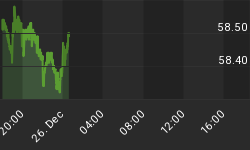The following is part of Pivotal Events that was published for our subscribers November 2, 2012.
SIGNS OF THE TIMES
"Chinese industrial company profits dropped 6.2 percent in August from a year ago, the largest decline this year and the fifth straight monthly deceleration."
- Bloomberg, October 22
"Bernanke: You can't fire me - I'm going to quit in 2014"
- Business Insider, October 23
Weird thinking - but, can that be made retroactive? To around now!
"It's bad luck to kill wizards."
- Arnold Schwarzenegger, in Conan The Barbarian (1982)
"Rural Savings Threatened After Collapse"
- Sydney Morning Herald, October 25
The article was about a non-bank lender that had been paying high interest on debentures and lending it out as mortgages or commercial property loans.
"Ford will shut three European plants, its first factory closings in the region in a decade."
- Bloomberg, October 25
Credit Markets
Ross noted in September that trends in money market stuff run "forever". That's the instruments with maturities of less than a year. Specifically, the Ted-Spread continues to narrow. At 0.581 as the mini-panic ended in late 2011, the spread-ratio has narrowed to 0.203 this week - clocking 19.4 on the Weekly RSI.
The chart begins in early 2008 and the previous most extreme was 23 in 2009. The trend change, and it is uncertain when it starts, will reflect a profound change in the main credit markets.
Within the Ted is the 3-month Libor and its Weekly RSI is down to 6.6. It was as low as 8 with the reversal in March 2008. The jump that began in that fateful September marked that disappearance of liquidity in the London Interbank Offered Rate. That was a shock to the current generation in the money markets, as well as in central banking.
Can this reverse?
Yes!
When?
????
What would be the mechanism?
The ability of governments to run increasingly reckless policy through their central banks has always depended upon the gullibility of the general public. Also prevalent has been the assumption of unlimited funding through confiscatory tax collections and unlimited abilities to issue credit/currency.
Obviously, taxpayer complacency is ending. Most taxpayers have had to tighten their belts and have been attempting to force thrift upon their extravagant governments. The more immediate effect has been upon local governments. State or provincial governments are one-step more remote, but will eventually be forced to be accountable.
In so many words, the "makers" have had it with the "takers".
The paramount evil has been the federal level with not just the prerogative of issue, but increasingly evident lately, the ability to buy endless amounts of bonds out of the market.
Historically, practically and morally this has been absurd and will be overwhelmed by political and market forces.
The drive to today's outbreak of bureaucratic despotism began around 1900 and where traditional means of US finance were limited by the constitution, the Federal Reserve System subverted this on the way to providing virtually unlimited finance.
As late as the mid-1960s the latter was considered impossible, but lately it has been widely accepted and widely discounted as "printing money". The latest belief-surge maxed out on September 14th and a significant decline seems to have started.
This would mainly involve stocks and commodities and it is doubtful that even the most desperate of central bankers would be willing to add these to their buying mania. Stocks and commodities don't have a maturity date.
Some may ask about the distress we expected "this fall" in most bond markets. In June-July the bond future soared up to a magnificent high that triggered our technical models. A significant price decline was possible. Maybe twenty points but the ten-point slump finished the move and stability is easing the overbought condition.
Similar strong overboughts were sequentially registered on corporates (LQD) and emerging debt (EMB). There are two ways of getting rid of an outstanding overbought condition. The one we prefer is the straight down; the other is a period of consolidation. The latter has prevailed and perhaps the continuous and big bid by central bankers is helping.
The long bond has been rallying with the setbacks in stocks and commodities. There is nothing new to this, and it could continue over the next number of weeks.
Treasury bill rates are at "Depression" lows but corporate bond yields are not at "Depression" highs. This "divergence" can't last forever.
Currencies
China's announcement of massive stimulus prompted a review of their currency system, which used to have holes in each coin. Today's coins no longer feature these, but their monetary theories are full of holes.
To be serious, the Dollar Index traded down to 79.1 on Wednesday, which level was support from early October. Today's jump marks that as a successful test of the low and reaching 80.5 marks the break above 80.25 resistance.
Tuesday's ChartWorks pointed out that with the break out the initial move could be to the 82 to 83 level. After consolidating the gain, the next target is around 90.
This could be considered as an involuntary trend towards "sound money", that would be your basic central banker's worst nightmare.
In time, this trend and widening popularity of "sound money" could fill the holes in Western monetary theories.
Link to November 3rd "Bob and Phil Show" on TalkDigitalNetwork.com: http://talkdigitalnetwork.com/2012/11/this-week-in-money-56/















